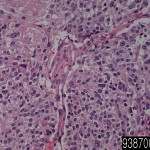| Product name | Adrenal gland pheochromocytoma |
| Cat. No. | 9387000A |
| No. of samples | 1 |
| Description | adrenal gland, pheochromocytoma Age/Sex : 46/M |
| Price | 197 EUR |
| 260 USD | |
| 170 GBP |
Product Related Literature
Adrenal medulla and pheochromocytoma pheochromocytoma, failed to involute or after birth, and noradrenaline (norepinephrine) adrenaline (epinephrine), usually neuroendocrine tumors collected a large amount of hromafinna adrenal tissue outside of catecholamine to a lesser extent. The closely related (described as adrenal pheochromocytoma often) adrenal paraganglioma extremely, but it is less common, it is known on the basis of the origin of the main dissected and derived from the ganglia of the sympathetic nervous system tumor was. The pheochromocytoma can cause resistant hypertension. pheochromocytoma can be fatal if it is the cause of severe hypertension or malignant hypertension. This high blood pressure is not controlled with standard drug for high blood pressure often. All patients did not experience the signs and symptoms are all listed. The most common type is an increase in heart rate and sweating attack by decay of less than one hour, headache, excessive.
I can be 25% of pheochromocytomas are inherited. Mutations of the gene, basketball, RET, NF1 (Gene 17 neurofibromatosis type 1), can lead to familial pheochromocytoma / extra-adrenal paraganglioma are known to SDHD and SDHB. Pheochromocytoma is a tumor (MEN IIB of Alias and MEN IIA, respectively) of type IIB and multiple endocrine neoplasia syndrome type IIA. Parathyroid adenoma, and neoplasm of other components of this syndrome is medullary thyroid cancer. Mutations in RET proto-oncogene is leading autosomal, a malignant tumor of these. May account for medullary sponge kidney as well common mutations in RET oncogene. You may be caused by mutations of the RET carcinogenesis pheochromocytoma associated with MEN II. Pheochromocytoma, and both syndromes are characterized by thyroid cancer (medullary thyroid cancer). MEN IIA is also, I exhibit hyperparathyroidism while men IIB also exhibits a mucosal neuroma. Well, this is not certain, but Abraham Lincoln, concluded that it does not, suffered MEN IIB, the idea Marfan syndrome, described above. Pheochromocytoma is associated with neurofibromatosis.
Diagnosis, can be determined by measuring the plasma catecholamines and metanephrines in (blood), or by 24-hour urine collection. In order to exclude adrenaline hypoglycemia affecting the catecholamines, such as block ganglion antihypertensive drug stimulants attention, methyldopa, or dopamine agonists, stress, exercise, and drugs (such as adrenaline) and other causes of excess must be noted. I can (coffee, tea, bananas, chocolate, cocoa, citrus, vanilla, for example) other foods also affect the level VMA and metanephrine of urine (vanillylmandelic acid). Imaging by MRI T2 and CT scan of the abdomen head, neck, and chest, may help to localize the tumor. Tumors, can be deployed using MIBG scan in scintigraphy using iodine 123-level meta-iodobenzylguanidine. However, fine location allows PET scans PET / CT, is obtained in the center of some F-18-fluorodopamine in (FDOPA)
I occur most often in young adults in adult life pheochromocytoma middle.
(Male) is assigned multiple endocrine neoplasia, these tumors can form a pattern of endocrine cancers other. The pheochromocytoma, may occur in patients with (men 2B) male and 3 MEN 2. Patients also von Hipperurindau, you may want to develop these tumors. Patients with symptoms associated with pheochromocytoma, please note that this is rare. As can select that during episodes of anxiety and take reasonable measures to ensure the doctor important clues as recording apparent significant whether a change in blood pressure, however, it often until autopsy patients It remains to be diagnostic.
In adults, a loneliness about 80% of pheochromocytoma and unilateral, 10% are bilateral, is outside of the adrenal gland is 10%. In children, between the two countries, quarter of the tumor, adrenal quarter is additional. Somehow, single lesion prefer right. Pheochromocytoma, may grow large in size (> 3 km), but weighing <10 cm weight <100 g, diameter most. Pheochromocytoma is very vascular. It consists of a large tumor, polyhedron, in pleomorphic cell hromafinna. Less than 10% of these tumors, it is malignant. Available which can be determined by tumor as with endocrine tumors of some other includes a cell four or multiple aneuploidy is determined tissue type of malignant tumor, by flow cytometry, which recurs is high. Local infiltration of distant metastases or surrounding tissue shows malignant.
Adrenal pheochromocytoma: 20-40 grams usually, adrenal pheochromocytoma, weigh the <5 cm diameter weight. Most of them are located in the abdomen in connection with the abdominal cavity of Zuckerkandl, mesenteric, and organs inferior mesenteric ganglion. Generally, about 10% of a 1% chest, less than 3% for cranial branch of the ninth cranial nerve or sympathetic ganglia, and, with the neck, in the bladder.

